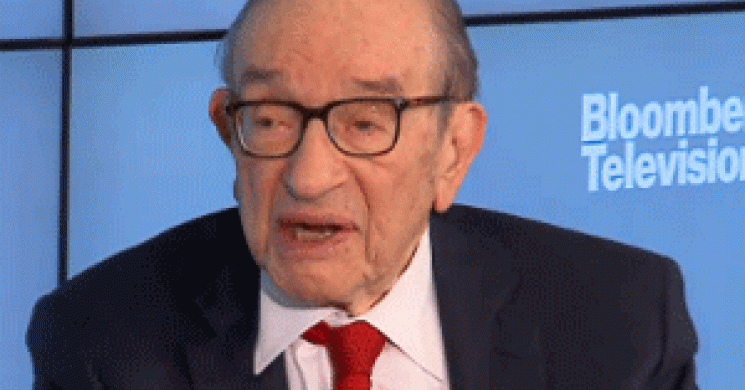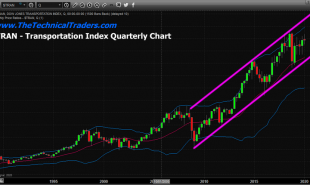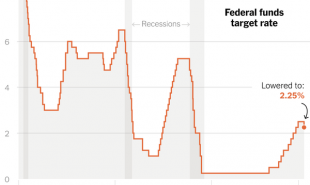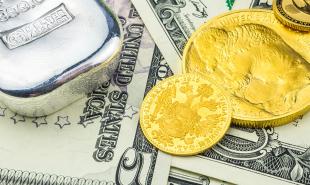
In a June 22nd missive to his paid subscribers, Michael Oliver stated that if the U.S. T-Bond managed to rise above the parallel channels shown on the chart above, it would suggest that the T-Bond is setting up for an exhaustive upside blow-off top. Specifically, Michael’s momentum work identified a T-Bond price of 170 that if exceeded by the end of June would signal odds for an exhaustive upside blow-off top that would end the 35-year bull market in U.S. Treasuries.


Well the verdict is in. The chart above right shows that the T-Bond finished the month of June at $173.22, or $173.6875 if you don’t like to deal in 32nds. I hope to ask Michael about this matter on my radio show next Tuesday, but clearly, based on his June 22nd missive, the table is set now, not for a whimper-like end of the greatest bubble bull market in history—the bull market for long-dated U.S. Treasuries, but for a possible violent reversal, sending interest rates rising very, very dramatically. To quote Michael, “If it (T-Bond market) opts to blow off to the upside first, then it’s likely the subsequent failure down through this up-trending structure will be even more savage than if it simply withered and dropped through the uptrend without having entered into a blow-off phase before the downturn.”
Does Greenspan’s Warning of Inflation Make Any Sense?
 On June 27, Alan Greenspan appeared on Bloomberg TV and Radio to talk about Brexit and the global economy. When asked what indicator he was paying most attention to these days he said, “M-2 Money supply.” He noted that M-2 (chart above right) has been growing through June at about a 7% to 8% rate. That is of concern to him, he said, because M2-correlates very well to consumer prices. So he voiced his concern that we could start to have rising prices, and in the context of these artificially low interest rates that could be a huge problem.
On June 27, Alan Greenspan appeared on Bloomberg TV and Radio to talk about Brexit and the global economy. When asked what indicator he was paying most attention to these days he said, “M-2 Money supply.” He noted that M-2 (chart above right) has been growing through June at about a 7% to 8% rate. That is of concern to him, he said, because M2-correlates very well to consumer prices. So he voiced his concern that we could start to have rising prices, and in the context of these artificially low interest rates that could be a huge problem.


Now, let’s go back to what Michael Oliver is saying as discussed above. He is warning us that what his work is now suggesting is that we are getting set up for a massive and climactic and violent end of the T-Bond bull market and that when markets end in a blow off, they typically reverse violently, meaning that we can expect a sudden rise in interest rates, no matter what the will of the Fed desires.
Let’s think for a minute why rates could suddenly rise even as the global economy seems to be slowing down and as central banks around the world continue to create endless trillions of dollars of currency out of thin air.
- A rise in inflation – When Dr. Greenspan was challenged to show where there is any inflation in the system, he noted that if you look at history, all situations like the one we are in now result in inflation problems. He also noted that an economy can trend along with little or no inflation in sight for quite a while, but then all of a sudden it seems to appear from nowhere with a hockey-stick-like impact, as the chart above right shows of the German mark as measured in gold. The key is money supply growth, and Greenspan said he is worried about what he sees in M-2. As it becomes obvious, especially to wealthy investors, who tend not to notice a rise in the cost of living nearly as soon as average-income people become aware that we have a real inflation problem, I can guarantee you they will withhold lending to the Fed without getting much higher rates. And the more pronounced rise in inflation, the higher the interest rate they will demand. We saw a little of this in the late 1970s, when Fed Chairman Paul Volcker put his foot on the money-creating accelerator at the Fed. The result? My first mortgage in 1981 was a 17.5% mortgage!
 A loss of confidence in the Fed – Low interest rates imposed on the economy over the past number of years are lethal and are responsible for a stagnant global economy. That is true because by denying price discovery of capital, you destroy capitalism itself by sending money into nonproductive uses. Hence cash flows are increasingly inadequate to service growth of debt from which phony fiat money is manufactured. Not only have central banks failed to understand this basic economic fundamental, but they continue to double down on this pathological policy forcing rates into negative territory against all semblance of common sense! Low rates are pathological but negative rates are the nail into the coffin that assures a violent end to the established economic and social order. Indeed banks, especially European banks, are running toward insolvency now because low rates are crimping or even eliminating profit margins on lending. Talk about a disincentive to lend and grow the economy. Negative rates are indeed the nail in the coffin! When people finally understand beyond the fog and smoke of mainstream propaganda that the system is broke and that the Fed is the cause, there is no question that people who still manage to have maintained some wealth will no longer part with their savings without significant compensation. And the more dangerous and unstable it is, the higher the returns that will be demanded. People will no longer be willing to send their money to the Fed for a fraction of 1% interest rates. That will happen after Michael’s exhaustive T-Bond blow-off occurs and that will be when a psychological change takes place, sending money velocity soaring. As people lose confidence in the purchasing power of fiat money, they will exit it as soon as possible and buy tangible items that do not lose their utility as fiat money so quickly does. This change of confidence can take place very rapidly, which accounts for the hockey stick rise during a hyperinflation.
A loss of confidence in the Fed – Low interest rates imposed on the economy over the past number of years are lethal and are responsible for a stagnant global economy. That is true because by denying price discovery of capital, you destroy capitalism itself by sending money into nonproductive uses. Hence cash flows are increasingly inadequate to service growth of debt from which phony fiat money is manufactured. Not only have central banks failed to understand this basic economic fundamental, but they continue to double down on this pathological policy forcing rates into negative territory against all semblance of common sense! Low rates are pathological but negative rates are the nail into the coffin that assures a violent end to the established economic and social order. Indeed banks, especially European banks, are running toward insolvency now because low rates are crimping or even eliminating profit margins on lending. Talk about a disincentive to lend and grow the economy. Negative rates are indeed the nail in the coffin! When people finally understand beyond the fog and smoke of mainstream propaganda that the system is broke and that the Fed is the cause, there is no question that people who still manage to have maintained some wealth will no longer part with their savings without significant compensation. And the more dangerous and unstable it is, the higher the returns that will be demanded. People will no longer be willing to send their money to the Fed for a fraction of 1% interest rates. That will happen after Michael’s exhaustive T-Bond blow-off occurs and that will be when a psychological change takes place, sending money velocity soaring. As people lose confidence in the purchasing power of fiat money, they will exit it as soon as possible and buy tangible items that do not lose their utility as fiat money so quickly does. This change of confidence can take place very rapidly, which accounts for the hockey stick rise during a hyperinflation.
Evidence That Smart Investors Are Now Losing Confidence – Evidence of a loss of confidence is starting to become obvious and there is little doubt but that the Presidents Working Group (aka the Plunge Protection Team) is manipulating the stock market to keep it from crashing. At the very least you can see that is happening with the constant head fakes by the Fed indicating the economy is “strong” and that they will therefore raise rates. Time and time again they have failed to raise rates after the stock market throws a tantrum over the mere suggestion of a rate rise. And as we just saw following the Brexit vote, the Fed soothed the market by allowing it to know a rate rise any time soon is off the table.
John Crudele at the NY Post has been writing for years about how the Fed is manipulating the stock market either directly or through the Plunge Protection Team. David Stockman said much the same this past week in one of his articles. But even major investors like Peter Fisher of Black Rock or famed investor Stan Peter Druckenmiller have made it clear they believe the Fed has lost its way and that it is clueless as to how to proceed. Druckenmiller has made the point that it was the high interest rates in the late 1970s that made the massive bull market in stocks and bonds possible over the past few decades. Now that rates are so extremely low, we are destined for a long bear market in financial assets. His top asset category is gold!
Another bit of market behavior that points to a rigged stock market is the fact that neither the gold market nor the T-Bond market is buying Fed propaganda that all is well. (Refer again to the T-Bond chart above.) If the markets are doing so well, why has money from the likes of the Druckenmillers and George Soroses of the world flowing into gold? And why, if people believe the real economy is on the mend as the Fed falsely suggests it is, are they not taking money out of both gold and T-Bonds to buy stocks? Clearly the strong rise in T-Bonds and gold suggests that a large number of investors or at least the largest and most influential heavy hitting investors are not doing so.
Indeed, as we open the month of July, the monthly gold price chart above left shows that the monthly average has broken decisively above both the 20-month average and the 40-month average. This is still more confirmation that the bull market in gold that got underway in February is for real.


But I also want to call your attention to John Exter’s inverted pyramid, which predicted what would happen when central banks continue to create unlimited amounts of debt-based fiat money. Early in the long-wave cycle, items of luxury and high risk high return gambles are undertaken with reckless abandon. However, at some point, the system reaches the limits to which it can expand. Like a ball tossed in the air, when it reaches that zenith, it starts in reverse. That most certainly is where the U.S. and global economy is now. Applying Exter’s inverted pyramid to this lesson of physics, when the economic system reaches the maximum stage of expansion, the items at the top of this diagram—those that are most luxurious, risky, and illiquid—are sold in favor of items toward the bottom of the pyramid. We most certainly started seeing this “deflationary” contraction starting in 2000 with the dot-com bubble. Following the implosion of the dot-com and housing market bubbles, rather than allowing the system to correct back to equilibrium, more and more debt money has been created faster and faster until an ultimate end of the fiat system itself is nearing its end.
I have added the picture of bars of gold at the bottom of Exter’s pyramid as a result of a discussion I had a few years ago with Barry Downs, the son-in-law of John Exter himself. Barry pointed out that John always saw gold as not being a part of his inverted pyramid but rather as being outside of the paper fiat system upon which everything within the pyramid was priced. I labeled the gold at the bottom of the pyramid (green area) as being “virtual” gold because it is make-believe gold that is owned in instruments like futures contracts and ETFs that do not require actual physical possession of gold but pretend to be the same thing as physical gold. As David Jensen has pointed out at JayTaylorMedia.com, massive paper instruments pretending to represent hundreds of times more physical gold (and silver) than actually exists are held by investors who think they own the real thing. We have been seeing a huge amount of gold ETFs being purchased as well as futures contracts, which has driven the paper price of gold higher.
In my interview with Ron Paul last week, which will be aired this-coming Tuesday on my radio show, I asked him what will happen not if but when savers demand higher interest rates, due to the dynamics I noted above. He said without hesitation, “that’s when the ball game is over!” And as I pondered John’s inverted pyramid, I had to conclude that that is when gold will rule supreme as a store of wealth. Here is how I see it. Rising levels of inflation caused by shortages (thanks to interest rate policies and mal investment) will result in skyrocketing interest rates. That in turn will lead to a global depression that can no longer be sugarcoated. With that, a total loss of confidence in the system will result in massive doses of helicopter money doled out to the poor and middle class, sending prices rising into a hyperinflation. At that point in time, everyone will attempt to exit Exter’s inverted pyramid completely. No longer will Wall Street types be satisfied with virtual (paper gold). Indeed. Ron Paul is right. When rates start to rise by even a little, it will be “game over.” Unless you own gold or life-sustaining tangibles you will have nothing left in this world to hang on to. What the politicians will do at that point is open to speculation. But one thing I would suggest is that you consider owning gold shares as well as gold bullion. It could very well be that gold will be called in, much as Roosevelt called in gold in 1933 in order to rebuild the Fed’s balance sheet, which will have been destroyed with the advent of helicopter money aimed at an unsuccessful pacification of the masses. Keep in mind that during the 1930s gold miners were the only asset class that not only preserved wealth but made investors downright wealthy. It could happen again. Keep that in mind now that we are in the early stages of this gold bull market for the ages that began in 2002.
Jay Taylor www.jaytaylormedia.com www.miningstocks.com
Read more by MarketSlant Editor







